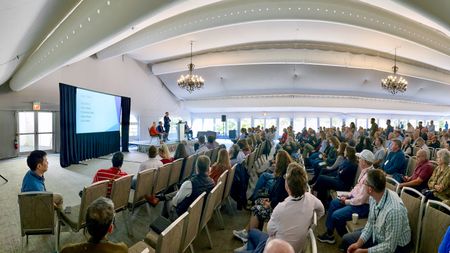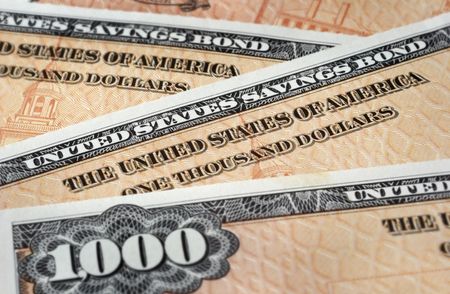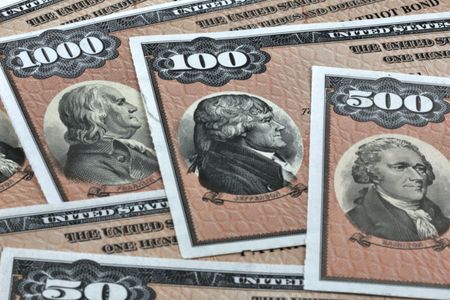Buy Munis at a Discount
Get even higher yields with closed-end funds. But make sure you understand the risks.

Sell now, ask questions later. Such has been Wall Street's mantra of late, as subprime woes have spread to traditionally safe investments faster than you can say "mortgage crisis." Municipal bonds, one of the most surprising casualties of the credit-crunch pileup, dropped 4.2% in February, their biggest monthly loss in more than 20 years. But intrepid investors may find enticing deals on munis if they shop among discounted closed-end funds.
Buying municipal bonds is about as wholesome as investing gets. State and local governments and related entities issue the bonds to finance projects for the public good, such as building hospitals and schools. Uncle Sam boosts the appeal of munis by exempting their interest from federal income tax. The recent 4.0% average yield of insured, ten-year triple-A-rated munis looks pretty good next to the ultra-safe 3.5% yield of ten-year Treasury notes. But the muni advantage is even more impressive when you account for the tax benefits. For an investor in the 28% federal tax bracket, a 4.0% tax-free yield is equivalent to a 5.6% yield from a taxable bond. For a taxpayer in the top 35% bracket, it's equivalent to a taxable yield of 6.2%.
When it comes to safety, munis lag only Treasuries. Investment-grade munis, or those rated BBB- and above in Standard & Poor's system, are one-thirtieth as likely to default as investment-grade corporate bonds are. Defaults among top-rated AAA municipals are virtually nonexistent. (For more on the attraction of munis, see Steals in Tax-Free Bonds.)

Sign up for Kiplinger’s Free E-Newsletters
Profit and prosper with the best of expert advice on investing, taxes, retirement, personal finance and more - straight to your e-mail.
Profit and prosper with the best of expert advice - straight to your e-mail.
Credit-crunch victims. Investors in closed-end muni funds have been spooked by recent market events, and rightfully so. Closed-end funds -- which issue a set number of shares, then trade on exchanges like stocks -- often use borrowed money to pump up yields.
The lifeline of these funds for borrowing money -- arcane vehicles called auction-rate preferred shares -- entered a deep freeze in February, when buyers stopped showing up at the auctions at which the preferred shares are sold. The freeze-up poses two major risks. The funds may have to de-leverage, or sell bond holdings at fire-sale prices, to repay borrowed money. Or they may have to cut dividends to meet increased borrowing costs. Neither has happened yet.
Another specter haunting muni investors is uncertainty about bond insurers. Some insurers, including industry leaders Ambac and MBIA, expanded into the business of guaranteeing exotic mortgage securities. As a result, they've run into financial trouble and could lose their triple-A ratings. If that were to happen, the bonds they guarantee would also lose their top ratings.
Some analysts say the risks aren't as great as they seem. "The market's already figured it's not getting any insurance," says Mariana Bush, a closed-end-fund analyst with Wachovia Securities. So, for example, an insured muni that would be rated A without insurance is "already trading like a single-A," she says. Muni investors today get the benefit of insurance (however flimsy) for free.
The deals on munis themselves are tough to pass up. After a bout of selling by hedge funds in late February, many tax-free bonds yielded more than comparable Treasuries. Because of munis' tax breaks, that's just not supposed to happen. "This is a tremendous buying opportunity," says Matt Fabian, managing director of Municipal Market Advisors.
Closed-end edge. The beauty of investing through closed-end funds is that you can buy an already marked-down asset (in this case, muni bonds) on the cheap. Share prices of closed-end funds vary with supply and demand. In an ideal situation, you can buy a closed-end fund at a discount to its net asset value (NAV) per share and either hold it for the long haul or sell it when the discount narrows or turns into a premium.
The vast majority of closed-end muni funds employ leverage. If you want to keep risk down, stick with an unleveraged fund. Nuveen runs most of the unleveraged offerings, including Nuveen Select Tax-Free Income 2 (symbol NXQ), a favorite of analyst Bush. Tom Spalding, the fund's manager since 1999, draws on 16 Nuveen analysts to locate IOUs in undervalued sectors of the muni market. Analysts typically meet with bond issuers to assess their financial strength and plans for repaying the debts. Nuveen generates its own assessment of the creditworthiness of issuers, so it isn't overly reliant on the judgments of credit raters such as S&P and Moody's.
Spalding sticks to high-quality issues. More than 60% of the fund's assets are stashed in triple-A-rated bonds. In mid March, the fund traded at a modest 2% discount to NAV and sported a current yield of 4.9%. That's equivalent to a 7.5% taxable yield for an investor in the 35% tax bracket. The fund's average duration, a measure of interest-rate sensitivity, was recently 5.4 years. That suggests that the fund's NAV per share would fall about 5.4% if interest rates rose by one percentage point. Annual expenses are a modest 0.34%.
Nuveen Select Tax-Free Income 3 is also a fine choice. Spalding runs it the same way he does its cousin, but it tends to own more lower-rated bonds. The fund (NXR) recently traded at a 2% discount to NAV and yielded 4.7%. However, its duration was less than five years, suggesting a bit less interest-rate risk than Select Tax-Free Income 2. Expenses are 0.35% a year.
Another unleveraged fund that Bush recommends is Morgan Stanley Insured Municipal Securities (IMS). Managers Steven Kreider, a former receiver in the National Football League, and Neil Stone invest all the fund's assets in insured triple-A-rated securities. That might sound like a big gamble on insurers, but, as Fabian points out, muni issuers generally must qualify for a triple-B rating on their own merits to obtain insurance. The fund's current yield of 4.6% is equivalent to a 7.1% pretax yield for an investor in the 35% tax bracket. Its duration is 7.4 years.
Riskier fare. If you're willing to go out on a limb, you may find leveraged muni funds rewarding. On average, leveraged funds sold at a 5% discount in mid March. Those discounts may widen if problems in the preferred-shares markets aren't resolved soon.
One attractive leveraged fund is BlackRock MuniYield Quality (MQY). Manager Michael Kalinoski invests almost exclusively in insured bonds (88% of assets at last report). He participates in weekly conference calls with BlackRock's global team to get a snapshot of the entire bond market, then relies on BlackRock's 12 muni analysts to help him identify the best deals in terms of yield, credit quality and maturity. The fund recently traded at an 8% discount to NAV and yielded 5.3%, equivalent to 8.2% pretax for an investor in the 35% tax bracket. The fund's average duration is a high 10.2 years, and its expense ratio is 1.04% (expenses for leveraged funds tend to be higher than those of unleveraged funds because they include the costs of interest for borrowing).
A combination of leverage and junk is heaven for income hogs. That's the formula employed by Pioneer Municipal High Income Advantage Trust (MAV), which borrows and can invest up to 60% of assets in junk municipals. Manager David Eurkus and Pioneer's four-person muni team slice the U.S. into regional economies. Then, says Eurkus, "by region we invest in sectors that are important to the health and well-being of the economy." Muni High Income Advantage recently yielded 6.5%, equivalent to a whopping 10.0% taxable yield for an investor in the 35% bracket. The fund trades at a slight premium to NAV, and its expense ratio is 1.16%.
Get Kiplinger Today newsletter — free
Profit and prosper with the best of Kiplinger's advice on investing, taxes, retirement, personal finance and much more. Delivered daily. Enter your email in the box and click Sign Me Up.

-
 RMD Deadline April 1: Five Tax Strategies to Manage Your 2025 Income
RMD Deadline April 1: Five Tax Strategies to Manage Your 2025 IncomeTaxable Income The April 1, 2025, deadline for required minimum distributions (RMDs) is fast approaching for retirees who turned 73 in 2024.
By Kelley R. Taylor Published
-
 Rising AI Demand Stokes Undersea Investments
Rising AI Demand Stokes Undersea InvestmentsThe Kiplinger Letter As demand soars for AI, there’s a need to transport huge amounts of data across oceans. Tech giants have big plans for new submarine cables, including the longest ever.
By John Miley Published
-
 Best Banks for High-Net-Worth Clients 2024
Best Banks for High-Net-Worth Clients 2024wealth management These banks welcome customers who keep high balances in deposit and investment accounts, showering them with fee breaks and access to financial-planning services.
By Lisa Gerstner Last updated
-
 Stock Market Holidays in 2025: NYSE, NASDAQ and Wall Street Holidays
Stock Market Holidays in 2025: NYSE, NASDAQ and Wall Street HolidaysMarkets When are the stock market holidays? Here, we look at which days the NYSE, Nasdaq and bond markets are off in 2025.
By Kyle Woodley Last updated
-
 Stock Market Trading Hours: What Time Is the Stock Market Open Today?
Stock Market Trading Hours: What Time Is the Stock Market Open Today?Markets When does the market open? While the stock market does have regular hours, trading doesn't necessarily stop when the major exchanges close.
By Michael DeSenne Last updated
-
 Bogleheads Stay the Course
Bogleheads Stay the CourseBears and market volatility don’t scare these die-hard Vanguard investors.
By Kim Clark Published
-
 The Current I-Bond Rate Until May Is Mildly Attractive. Here's Why.
The Current I-Bond Rate Until May Is Mildly Attractive. Here's Why.Investing for Income The current I-bond rate is active until November 2024 and presents an attractive value, if not as attractive as in the recent past.
By David Muhlbaum Last updated
-
 What Are I-Bonds? Inflation Made Them Popular. What Now?
What Are I-Bonds? Inflation Made Them Popular. What Now?savings bonds Inflation has made Series I savings bonds, known as I-bonds, enormously popular with risk-averse investors. So how do they work?
By Lisa Gerstner Last updated
-
 This New Sustainable ETF’s Pitch? Give Back Profits.
This New Sustainable ETF’s Pitch? Give Back Profits.investing Newday’s ETF partners with UNICEF and other groups.
By Ellen Kennedy Published
-
 As the Market Falls, New Retirees Need a Plan
As the Market Falls, New Retirees Need a Planretirement If you’re in the early stages of your retirement, you’re likely in a rough spot watching your portfolio shrink. We have some strategies to make the best of things.
By David Rodeck Published